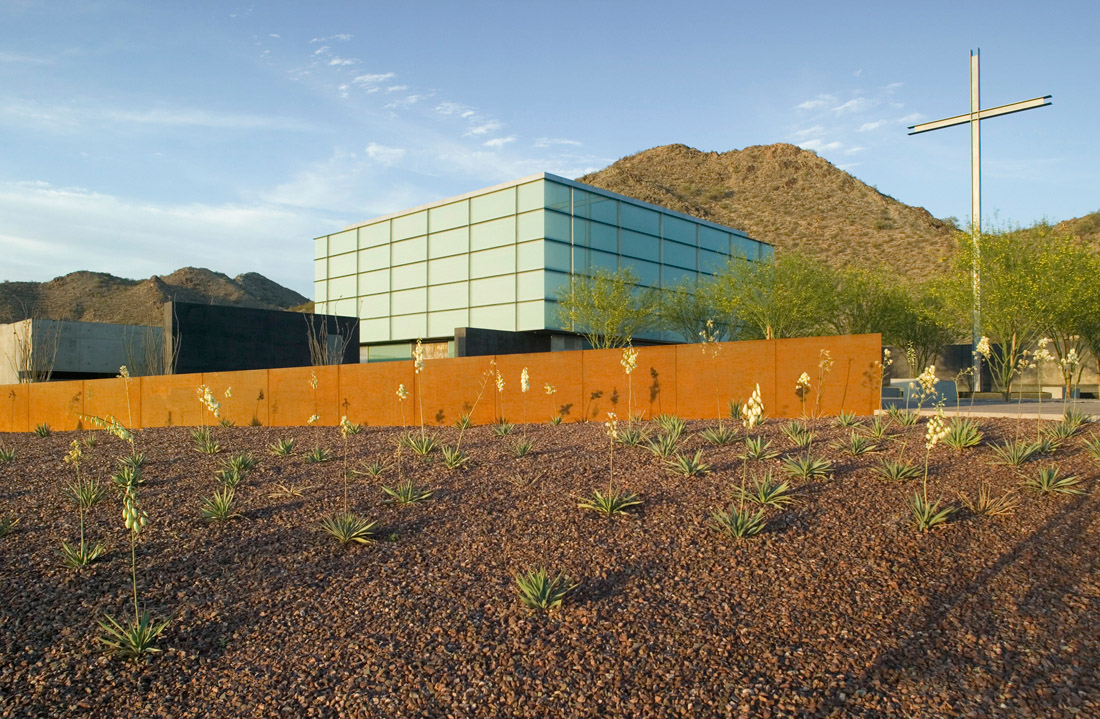반응형

Location: Phoenix, Arizona, USA
Project team: Jack DeBartolo Jr FAIA, Jack DeBartolo 3 AIA, J. Eric Huffman, Aaron Taylor, Tim Smith, Kent McClure
Civil + Landscape: wrg design
Structural Engineer: rudow + berry
Mechanical engineer: kunka engineering
Electrical Engineer: associated engineering
Contractor: arthur porter construction
Landscape Design: michael boucher landscape architect
Lighting Design: roger smith lighting design
Constructed Area: 578 sqm
Design year: 2003-2006
Construction year: 2007
Photographs: Bill Timmerman















A deep set steel channel, the narrow garden walk engages the botanical planes in provocative ways; looming, rusted steel walls gradually diminish to waist height, shielding the chapel while still offering views of the mountain ranges beyond.
Upon arrival the exposed-aggregate plaza is met by an orderly, yet inviting bosque of desert trees, offering an instant canopy of shade and an elevated vista of the horizon. Bordering the eastern edge of the plaza is a 70 foot-long black reflection pool. Emerging from the mirror-like surface of the water, a flame burns adjacent a 50 foot-high steel cross. Lit from below the water, the slender steel cross is visible for miles.
Envisioned as a ‘lantern on a hill,’ the minimal square chapel sits suspended eight feet above the ground, defined by four Vierendeel steel frames supported on a pinwheel of four black-concrete monolithic walls. Each wall anchors a corner of the ‘glass box’ chapel. The remaining length of wall extending into the landscape captures and defines three unique courtyards around the building.
The physical enclosure of the chapel is entirely glass. Above the eight foot datum, an outer steel frame is connected directly to the main structural frames and is glazed with a layer of fritted-translucent glass that, in turn, shades the inner-layer of triple-insulated translucent glass. The five foot-deep air-space created by the shaded void between the double skins is a natural convection air chimney, releasing hot surface-air while drawing cooler shaded-air along the face of the building. The convection chase and shaded skin eliminate direct sunlight upon the interior glass, creating a soft glowing interior and removing the need for electric light during the daytime.
Below the eight foot datum, and on three sides of the building, stacking, sliding glass doors define the interior and then retract, blurring the line between indoor and outdoor space. When the doors are opened, the chapel is transformed into a ‘pavilion’ able to accommodate thousands during the temperate months of the year.
Facing west, the processional entrance into the space is defined by translucent glazing which flanks a pair of monumental, cast-bronze doors artistically inscribed with the Lord’s Prayer. Lacking exterior hardware, hands will patina the doors over time, further revealing the haptic realm of the building.
The powerfully minimal interior is subject to the day-lit glow of the upper shaded glass as well as encompassing views of the surrounding landscape, near and distant, afforded by the transparent lower, clear glass. The flooring is a seemingly random pattern of deep charcoal granite. When air conditioning is required, it is carried underground from the adjacent support building and delivered from the eight foot datum.
Three distinct outdoor spaces are defined by the black concrete wall extensions: a paved piazza to the south, a turf lawn to the east, a desert gravel bosque to the north. Moreover, the east-facing sides of two of the four concrete walls contain more than 1000 columbarium niches to memorialize loved ones or inter remains.
Adjacent to the west lies a quietly reposed concrete support building, resolved to a simple rectangle nestled into the ground at the transition between entry garden and chapel mount. Within are offices, a meeting room, restrooms, and mechanical equipment, thus preserving the purity of the chapel as hallowed ground. Parking is located at the base of the garden entrance, also maintaining an appropriate pedestrian buffer between sacred and profane.
At night the glass pavilion is further transformed by light. Illuminated by hundreds of LED fixtures mounted between the double skins, ‘the lantern on the hill’ morphs into intense, sublime hues of color and shade, a glowing, unique, and fascinating environment created by each color shift.








from archdaily
그리드형
'REF. > Architecture' 카테고리의 다른 글
| [ Takaharu + Yui Tezuka ] Fuji Kindergarten, Tachikawa, Tokio - Japón (0) | 2009.01.24 |
|---|---|
| [ paulasertorio ] Adaptable architecture gallery (0) | 2009.01.23 |
| [ NL Architects ] ORDOS 100 #11 (0) | 2009.01.21 |
| [ dRMM ] Sliding House (0) | 2009.01.21 |
| [ Menis Arquitectos ] Jordanék Music Hall (0) | 2009.01.21 |